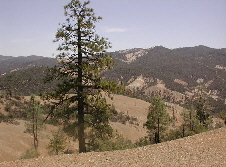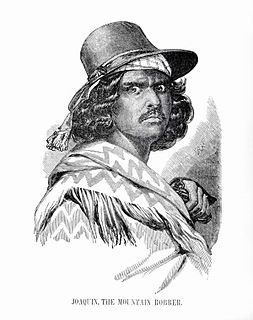
Arroyo Mocho is a 34.7-mile-long (55.8 km) stream which originates in the far northeastern corner of Santa Clara County and flows northwesterly into eastern Alameda County, California. After traversing the cities of Livermore and Pleasanton it joins South San Ramon Creek to become Arroyo de la Laguna, which in turn flows to Alameda Creek and thence to San Francisco Bay.
Point of Timber is a former settlement in Contra Costa County, California. It was located on Indian Slough 2 miles (3.2 km) north of Byron, and about 2.5 miles east of Union Cemetery in Brentwood. It was originally named Point of Timber Landing. The landing was built by Josiah Wills, who organized the deepening of Indian Slough, connecting the landing to the Old River. Point of Timber got its name from the mile wide strip of open Oak woodland that ran from just east of the house of John Marsh along the course of Arroyo del Sur to the edge of the marshes bordering Indian Slough and Old River.
Murrieta Rocks originally named Las Tinajas,, refers to the waterholes to be found eroded into the Vaqueros Sandstone on top of the outcrop. The location is at a large outcrop of Vaqueros Sandstone, called Murrieta Rocks, about a mile northeast of Brushy Peak just within the southern bounds of the Rancho Cañada de los Vaqueros in California. From the east the outcrop overlooks a spring in an eastern tributary arroyo to the upper Kellogg Creek that flows down from Brushy Peak.
Latta Creek is a tributary stream of Salado Creek in the Diablo Range in Stanislaus County, California. It has its source at 37°24′05″N121°19′33″W. Its mouth is at its confluence with Salado Creek. The creek is named for Eli C. Latta, a pioneer that came to California during the California Gold Rush and homesteaded the headwaters of the creek.
Castle Rock, originally known as La Centinela, is a pillar in Corral Hollow, in San Joaquin County, California. It rises to an elevation of 653 feet (199 m).
Kellogg Creek is a tributary of Indian Slough, in Contra Costa County, California. Indian Slough itself is a tributary of the Old River, an old channel of the San Joaquin River. Kellogg Creek was formerly named Arroyo Santa Ángela de Fulgino by Pedro Font, on April 4, 1776, as the expedition of Juan Bautista de Anza passed through the area. In the 19th century it was known to the Californios as Arroyo del Sur.
Adobe Mountain is a peak with an elevation of 3,207 feet / 977 meters in the Diablo Range in Stanislaus County, California.
Isabel Valley is a valley in the Diablo Range in Santa Clara County, California. It is also known as Santa Isabel Valley.
Mississippi Creek is a tributary stream to Pacheco Creek in Santa Clara County, California.
Valle Atravesado,, a small, east-west running valley that crosses the north-south running valley of the upper reach of Mississippi Creek in the Diablo Range, in Santa Clara County, California.
French Ranch, is a locale northeast of Hollister in the Diablo Range, in San Benito County, California. It lies on a flat just south of Wildcat Canyon at an elevation of 1,821 feet / 555 meters at the foot of Frenchs Pass. It lies west of an unnamed stream that descends northward to its confluence with Wildcat Canyon Creek from the north slope of Antimony Peak.
Frenchs Flat is a flat along the divide of the Diablo Range south of Pacheco Pass in Santa Clara County, California. It lies at an elevation of 1,362 feet / 415 meters south southwest of Pacheco Pass.
Mustang Peak is a mountain summit along the divide of the Diablo Range in Stanislaus County, California. It rises to an elevation of 2,251 / 686 meters.
Paradise Flat is a flat in the Diablo Range, within Henry W. Coe State Park in Stanislaus County, California. It lies at an elevation of 1,224 / 373 meters along north bank of the South Fork Orestimba Creek, just above the Rooster Comb.
Mustang Flat is a flat in the Diablo Range in Stanislaus County, California. It lies at an elevation of 1,329 feet / 405 meters south of the South Fork Orestimba Creek, north of Mustang Peak.
Frenchs Pass is a gap on the divide of the Diablo Range and on the boundary of San Benito County and Merced County, California. The pass is at an elevation of 2,428 feet / 740 meters on the north shoulder of 3,257 foot Antimony Peak.
Valle Hondo, a small flat in the canyon along the course of North Fork Pacheco Creek in Henry W. Coe State Park in Santa Clara County, California. It lies at an elevation of 1,698 feet / 518 meters. Formerly an Native American rancheria, then an overnight camp along La Vereda del Monte, and then for local ranchers, it is now the site of Pacheco Camp in the state park and is located where the Pacheco Creek Trail meets Coit Road, which borders the flat on its south side.
Fifield Ranch is a locale within the Diablo Range in Santa Clara County, California. It lies at an elevation of 1,512 feet / 461 meters, west of the head of Romero Creek and the Santa Clara County line, about a mile north of Hagerman Peak. It is at the source of a tributary canyon and stream to Chimney Gulch, itself a tributary of East Fork Pacheco Creek.
Mississippi Lake is reservoir on Mississippi Creek within Henry W. Coe State Park in Santa Clara County, California. It is also the largest reservoir in the park.
Bullhead Canyon, is a canyon and tributary stream of the North Fork Pacheco Creek in Santa Clara County, California. Its mouth is on its confluence with North Fork Pacheco Creek at an elevation of 630 feet / 192 meters. Its source and its upper reach is at 37°10′08″N121°19′04″W within the boundary of Henry W. Coe State Park. It is overlooked to the north by the County Line Road,, that runs west to east along the divide of the Diablo Range and the boundary of Santa Clara and Stanislaus County, California.




